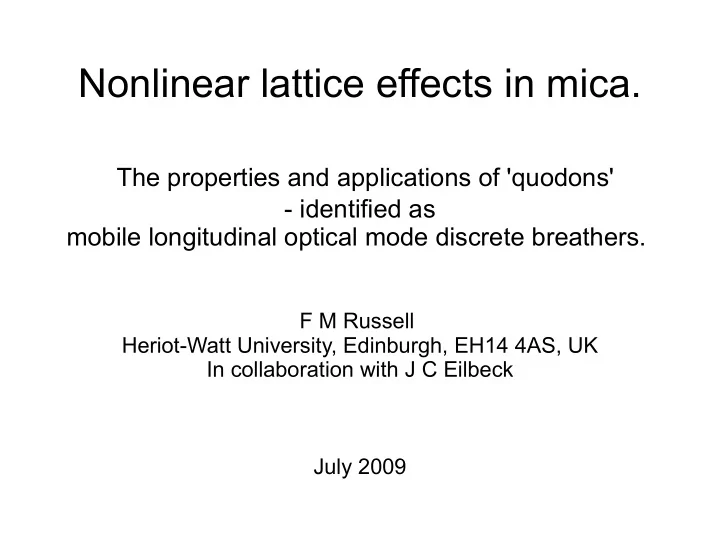

Nonlinear lattice effects in mica. The properties and applications of 'quodons' - identified as mobile longitudinal optical mode discrete breathers. F M Russell Heriot-Watt University, Edinburgh, EH14 4AS, UK In collaboration with J C Eilbeck July 2009
Main points of talk: 1. Quodon hypothesis. 2. Quodons can have high energies >100eV. 3. They can persist indefinitely in presence of thermal motion. 4. They produce head-on collisions of atoms. 5. They should cause fusion of light nuclei.
Quodon hypothesis. Study of tracks in mica. Natural crystals of muscovite mica can record nonlinear lattice effects at the atomic scale. ----- 1963 Tracks of charged particles identified ● Cosmic ray muons, K-decay ● positrons, protons, electron/positron showers, etc Local ionization of crystal ● Crystals grow >5km underground at ● temperature of 800K Contain impurities – mostly iron ● Crystals cool slowly – become super ● saturated Precipitation of impurity at +ve sites ●
Discovery of quodon tracks ---- in 1989 ● One cosmic ray muon ● All tracks joined up ● Unidentified tracks lie in atomic chain directions ● Two scattering events ● All tracks in one atomic layer ● Scattering of muon gives kinetic energy and momentum to lattice ● Then what happens?
What kind of lattice excitation? Shock waves, solitons, phonons or what? ● MD study of mica lattice points to chains ● Not Toda soliton – unstable ● Construct 1-D magnetic analogues with nonlinear forces and on-site potentials ● They show mobile breather- like excitations ● 1-D so only longitudinal optical motion possible
2-D Numerical simulations of mica lattice point strongly to quodons being longitudinal optical mode breathers ----- with J Marin, J C Eilbeck. 1998 But do quodons really exist? ● Critical test ● Bombard mica crystal with alphas at A ● After travelling through crystal a quodon should eject the last atom at B ● Verified by experiment ---- in 2005 ● Distance travelled 7mm equals >10,000,000 unit cells ● Temperature of crystal was ~300K
Verification of quodon hypothesis allows their properties to be studied by measurements on their tracks in mica. ● First, how to distinguish quodon tracks from charged particle tracks? ● Unique signature of quodon tracks – 'kinked-lines'
Two parallel quodon tracks originating from ends of a high energy proton track that is not in a chain direction. Quodons created by scattering of the proton.
Persistence and stability of quodons Longest length found of a kinked-line track is 530mm. Limited by size of crystals. Measurements on track width indicate <5% loss of energy, giving track length of >10m. No known crystal defects are on this scale. In a good quality crystal life of quodon is expected (predicted) to be infinite. Tracks recorded at temperature of ~700K, so stable against thermal motions.
What energy in a quodon? Found from decay of potassium 40 nucleus in mica. Three particle decay: positron, neutrino & recoil nucleus. Highest energy positron of 1.4MeV - lowest energy neutrino so positron and recoil nucleus move in opposite directions. Energy of recoil nucleus is 49eV About 80% goes in to quodon ~ 40eV. In mica with iron and calcium impurities the positron and quodon tracks are decorated differently. So these decays can be identified. MD study gives maximum energy of about 300eV
Summary of properties of quodons 1. Created by scattering of swift particles in crystals 2. Infinite life in insulating crystals with atomic sheets 3. Stable against thermal motion >700K 4. Maximum energy ~ 300eV 5. Cause head-on collisions of atoms 6. Interact with quodons on same chain
Effects on materials. 1. Effective temperature in quodon of 40eV is ~ 300,000K 2. Shakes atoms violently - relax to equilibrium positions 3. Anneals defects, allows phase transformations 4. Conducts kinetic energy from nuclear reactions without energy loss or temperature gradient 5. Repeatedly collides atoms head-on for quantum tunnelling through Coulomb potential barrier
Lattice Assisted Nuclear Fusion Based on known and understood physics 1. Lithium deuteride has sheets of D atoms; is an insulator and has high melting point of 962K 2. If quodons have infinite life then D/D fusions must occur no matter how small the fusion cross-section 3. Rate of fusion depends critically on the collision energy 4. If maximum quodon energy <300eV then probably not useful for power generation. { <<1 MW/cu.m} 5. If higher collision energies possible then might be useful
High energy events Track of high energy heavy particle in mica. Baryon not lepton. Scattering gives atomic cascades. Characteristic pattern of 2-D 'fans'. Fans give rise to multiple quodons. Energy in fans >>300eV Need to be studied.
Final comment In 1953 I saw a glass torus of 20cm diameter containing a glowing plasma on a laboratory bench. The underlying concept of fusion at high temperature in a low density plasma was based on known physics. Fifty six years and >$10,000,000,000 later ITER is being built. LANF also is based on known physics.
Recommend
More recommend